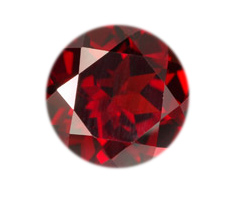The Clear Spring is bright and warm. The Clear Spring Color Palette is a set of wild, bright colors.
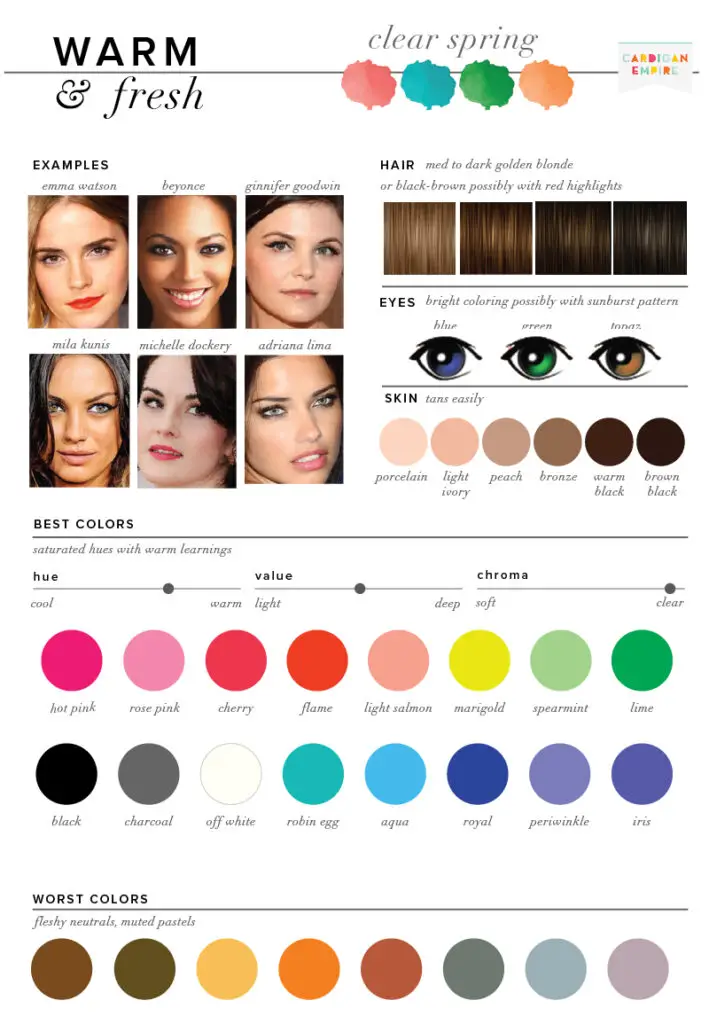
Its intensity can only be compared with that of the colors in the clear winter scheme.
Clear winter happens to be one of the three spring seasons and on the seasonal flow chart, it is set between clear winter and true spring.
This season is warm, which is contrary to the bright winter. Even so, the two are sister seasons.
This means that they are both a mix of winter and spring, with bright winter resting more toward the winter palette, whereas clear spring rests more towards the spring palette.
Warm and Bright
Clear spring is classified into three types: warm hue, bright Chroma, and medium or light value.
Compared to its fellow spring seasons, clear spring is different in the fact that Chroma is its primary feature.
There is an overall brightness to the features, even though there is a clearly defined warmth. The skin tends to be tan or gold.
However, normally, the eyes will be green, amber, or blue, which stands out against the face.
And, for the hair, is in the brown color family, ranging from light to medium or dark, and even possesses red-gold or faint auburn features.
The features are extremely high in contrast. The hair and eyes would be distinguishable against the skin if looking at a grayscale image.
Clear spring, which can also be referred to as “bright spring,” is extremely similar to clear winter.
However, they are still different in the fact that clear spring is a little bit lighter and can wear warm, bright colors.
General Characteristics Of The Clear Spring Color Palette
Clear springs, which are also commonly referred to as bright springs can be sometimes hard to recognize due to the fact that they tend to be categorized under light springs or true springs rather than if they are blonde.
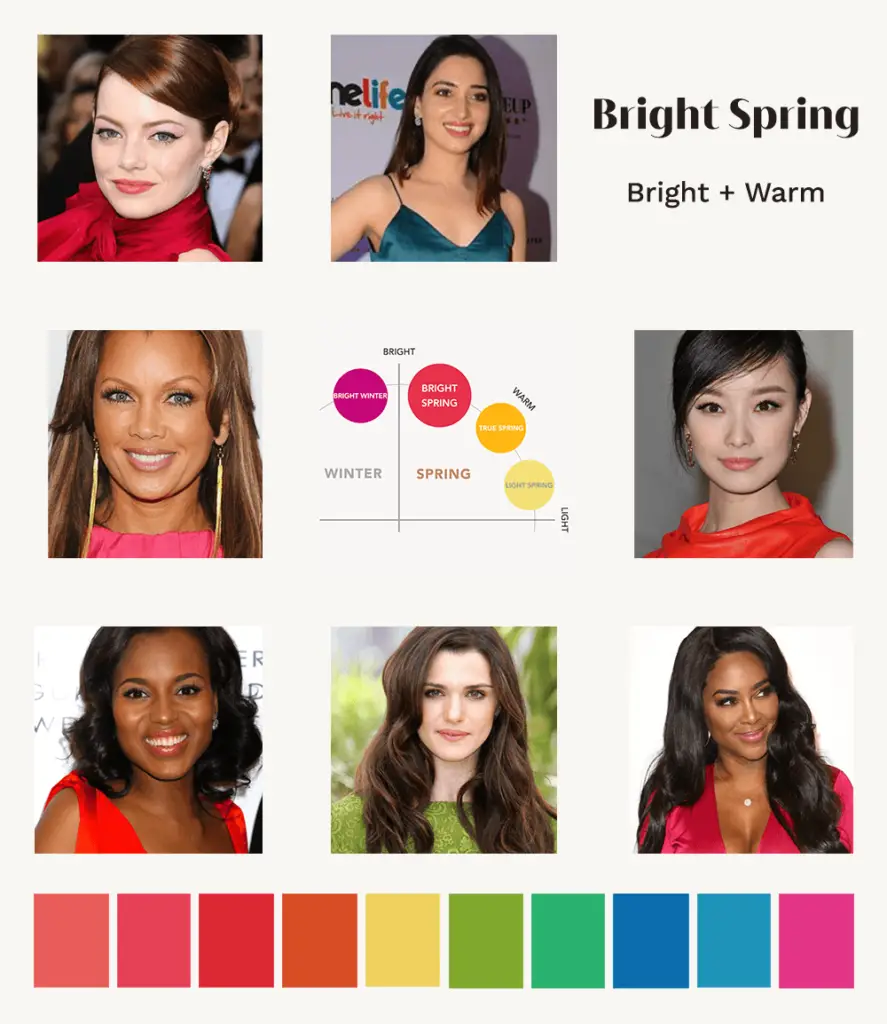
Anyway, below are some common characteristics of this season:
Hair
Normally, clear spring hair is golden blonde or brown with golden features. However, it can also be auburn and copper with highly contrasting pale skin that does not read as warm.
It’s quite important to note that clear springs have the tendency to possess lighter hair compared to clear winters, so it’s quite common to mistake them for true springs.
Skin
The skin of this season is usually peachy, porcelain, or ivory. Even women of color who are categorized under this season do have lighter and brighter skin.
Your skin has a greater tendency to have a warm undertone; peach and cream complexions are extremely common.
Clear springs have extremely fair skin, which is most likely to be slightly pinker compared to clear winters.
Their skin tone is frequently described as “peaches and cream” or “cocoa butter.”
Eyes
The eyes of clear springs will be vibrant and clear, the focal point of the face. They can be green, topaz, or blue.
And, as long as they are in extremely high contrast with the white of their eyes and their skin, they can be dark brown.
Most women of color who happen to be clear springs possess lighter eyes, either light brown or hazel, which are the most common tones.
Color Dimensions
If your features produce either an opposite type of contrast or if they are extremely saturated and defined, then you are a clear spring or a bright spring.
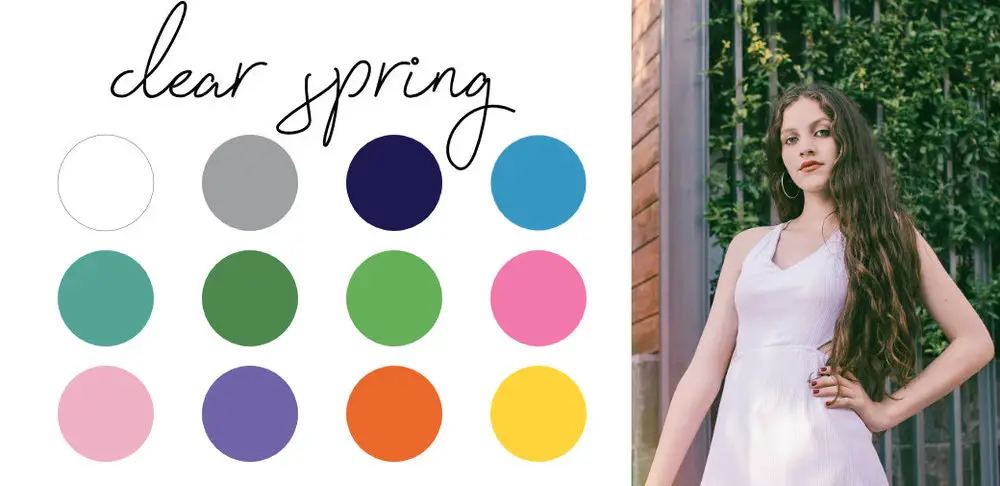
Its Chroma level is the main color aspect of a clear type in terms of how saturated the colors are.
A clear spring would be neither muted nor blended because tone and saturation are determined on a grayscale.
Contrast and Saturation
There are two types of contrast to help identify you as this type. The first type is a blend of opposites.
And the second item on the list is having a high saturation level. If you happen not to have a high contrast level, this is an extremely important aspect to check out.
You will have the ability to handle intense colors if you possess vibrant, saturated, and defined features.
You have a low contrast level if you have extremely dark skin and extremely dark eyes and hair.
Value
The default value level is medium, and it is determined by the person’s coloring.
So, it can be slightly lighter or darker. However, it won’t be much, thanks to the fact that it’s a tertiary feature.
Hue and Temperature
You will look perfect in warm colors, as a warm season. However, your colors will be warm if you are neutral warm but not very warm.
Also, you can wear some cooler colors. You must be able to wear bright colors if you have the feeling that this might be your type.
You can check if you look good in colors like a true orange, a true red, and a true yellow. Your opposite would be MUTED + COOL, since you are CLEAR + WARM.
Experiment and find out whether your worst colors are gray, pale blue, or pale pink.
Clothing Combinations
Bright Spring, which is also called “Clear Spring,” is a sub-season with the highest level of contrast.
That is to say that you can achieve color combinations that would appear bright and vibrant.
Harmonious, triadic, and tetradic color combinations are best suited for you.
They offer high contrast due to the fact that they are on the opposite side, like coral and blue.
Or simply too far apart on the color wheel. They appear brighter and more important, and they produce a confident and bright appearance.
It’s advisable to use one dominant color for triadic and tetradic combinations. And, the others as accent colors, as this helps balance your appearance.
And, to produce value contrast, you can blend dark and light colors. However, you appear better when you use other color contrast options in your palette.
For instance, pair a neutral with a vibrant accent. Either mix a dark neutral with a lighter, brighter accent color or just use a light neutral with a different, darker accent color.
Final Thoughts: Clear Spring Color Palette
Clear Spring is placed on the seasonal flow chart between True Spring and Bright Winter. This has already been mentioned above.
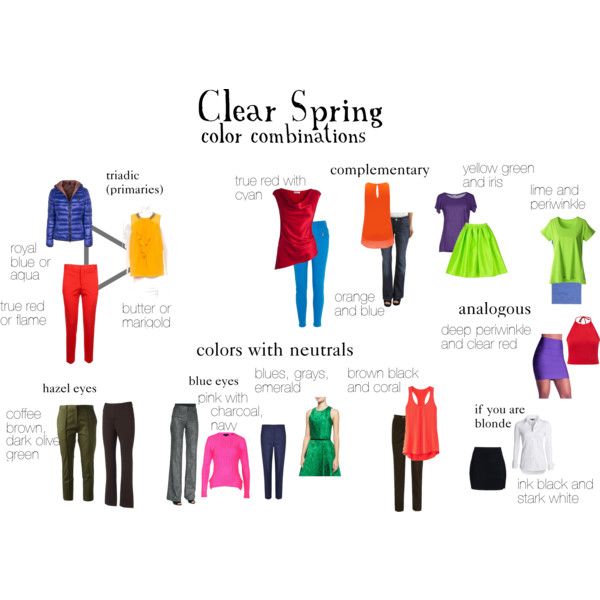
In the Spring family, Clear Spring colors happen to be the brightest. They are less dark, warmer, and more saturated compared to other Springs.
According to flow theory, bordering the Clear Winter makes the Clear Spring scheme cooler, brighter, and darker compared to other Spring seasons.
Clear Winters and Clear Springs both have vibrant coloring and high contrast, but Clear Winters has a slightly higher level of contrast than Clear Springs.
Clear Winters possess cool (blue) undertones; on the other hand, Clear Springs possess warm (golden, yellow) undertones.
Also, their colors are slightly darker compared to those of Clear Spring.
So, with all that being said, this concludes this comprehensive guide on the Clear Spring Color Palette.


